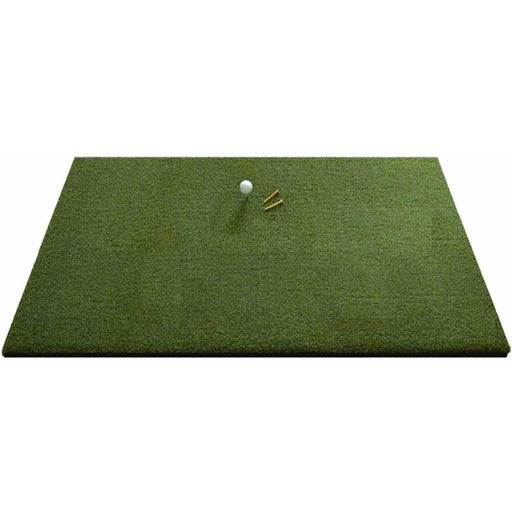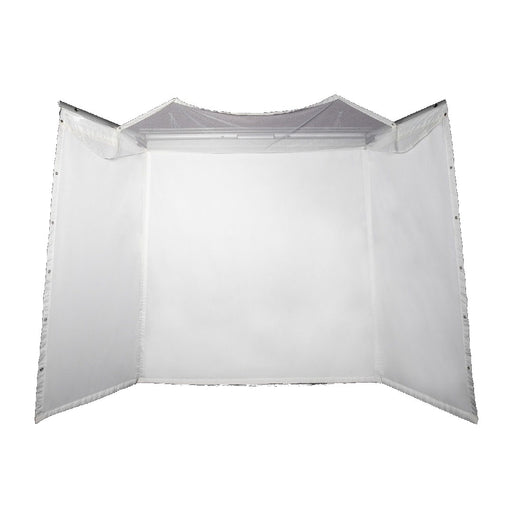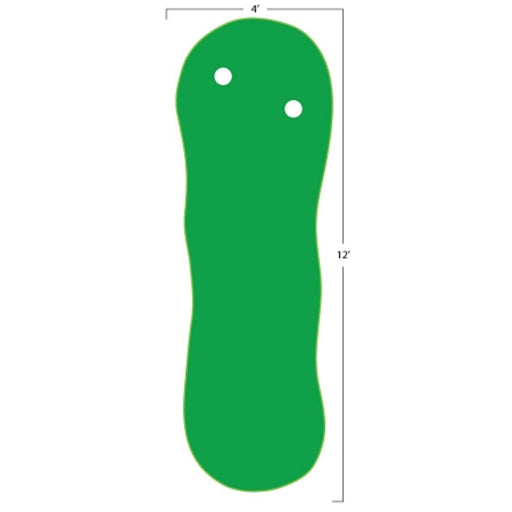Now through January 5th 15% OFF our very popular Vanish and Parlour Enclosures. Coupon code 15SWINGMASS

Choosing the Perfect Hitting Mat for Your Golf Simulator
Investing in a golf simulator is an excellent way to improve your game from the comfort of your home. One of the critical components of this setup is the hitting mat. A high-quality hitting mat can mimic the feel of real grass, protect your clubs, and enhance your overall experience. With numerous options available, selecting the right hitting mat can be overwhelming. This guide will walk you through the essential features and considerations to ensure you make an informed decision.
1. Durability and Longevity
- Materials and Construction - The longevity of a hitting mat largely depends on the materials used and the construction quality. Look for mats made from high-density turf, which can withstand repetitive impacts without wearing out quickly. Nylon and polyethylene are popular choices due to their durability and realistic feel. Additionally, mats with multi-layer construction tend to last longer as they distribute the impact force more evenly, reducing wear and tear.
- Backing Material - The backing material is crucial for the mat's durability and shock absorption. Mats with a thick rubber backing are preferred as they provide excellent stability and prevent the mat from moving during swings. A rubber base also absorbs impact, reducing the strain on your wrists and elbows.
2. Realistic Feel and Performance
- Turf Thickness and Texture - The thickness and texture of the turf significantly impact the feel of the mat. A mat that mimics the texture of natural grass will provide a more realistic practice experience. Opt for mats with a dense and thick turf layer, ideally around 1.5 to 2 inches. This thickness allows the club to glide through the turf, similar to how it would on a real fairway.
- True Divot Simulation - Some advanced mats are designed to simulate true divots, giving you feedback on the quality of your shot. These mats have a replaceable hitting surface that mimics the feel of taking a divot, helping you improve your swing mechanics and ball striking consistency.
3. Size and Portability
- Mat Dimensions - Consider the space you have available for your golf simulator setup. Hitting mats come in various sizes, from compact mats for small spaces to larger mats that accommodate full swings. Ensure the mat you choose fits comfortably within your designated area while allowing enough room for your full swing motion.
- Portability and Storage - If you need to move or store your hitting mat frequently, opt for a lightweight and portable option. Some mats are designed with handles or can be rolled up for easy storage. However, ensure that portability doesn't compromise the mat's durability and stability.
4. Shock Absorption and Joint Protection
- Shock-Absorbing Layers - Repeatedly hitting off a mat can be tough on your joints, especially your wrists, elbows, and shoulders. To mitigate this, look for mats with built-in shock-absorbing layers. These layers reduce the impact force transferred to your body, making practice sessions more comfortable and reducing the risk of injury.
- Foam Padding - High-quality mats often include foam padding beneath the turf layer. This padding enhances comfort and provides additional shock absorption, protecting your joints during extended practice sessions.
5. Club Protection
- Club-Friendly Surface - The hitting surface should be gentle on your clubs to prevent excessive wear. Mats with a soft and smooth surface reduce the risk of scratching or damaging your clubfaces and shafts. Avoid mats with abrasive or overly coarse surfaces that can accelerate club wear.
6. Versatility and Training Features
- Multiple Tee Positions - Versatility is essential for a comprehensive practice experience. Choose a mat that offers multiple tee positions to practice different shots and club types. Some mats come with pre-cut holes for rubber tees, allowing you to switch between irons, woods, and drivers seamlessly.
- Alignment Guides - Some hitting mats feature alignment guides or target lines embedded into the turf. These guides help you practice your alignment and aim more accurately, providing valuable visual feedback during your practice sessions.
7. Budget Considerations
- Price vs. Quality - While it's tempting to opt for a cheaper hitting mat, investing in a higher-quality mat can save you money in the long run. Higher-quality mats last longer and provide a better practice experience, reducing the need for frequent replacements. Set a budget that balances quality and affordability, ensuring you get the best value for your investment.
- Warranty and Return Policy - Check the warranty and return policy offered by the manufacturer. A solid warranty indicates the manufacturer's confidence in their product's durability. Additionally, a flexible return policy allows you to try the mat and return it if it doesn't meet your expectations.
8. Customer Reviews and Recommendations
- User Feedback - Customer reviews can provide valuable insights into the performance and durability of hitting mats. Look for reviews that mention the mat's feel, durability, and overall satisfaction. Pay attention to any recurring issues or concerns raised by multiple users.
- Professional Recommendations - Seek recommendations from golf professionals or instructors. They often have experience with various hitting mats and can provide informed advice based on their expertise. Professional endorsements can help you narrow down your options and choose a mat that meets your needs.
9. Compatibility with Your Golf Simulator
- Simulator Requirements - Ensure the hitting mat you choose is compatible with your golf simulator setup. Some simulators require specific mat types or thicknesses for accurate data collection. Verify the mat's compatibility with your simulator to avoid any technical issues.
- Sensor Integration - If your golf simulator uses sensors or launch monitors, check if the hitting mat integrates seamlessly with these devices. Some mats are designed with sensor slots or cutouts to accommodate various sensor placements, ensuring accurate shot tracking and analysis.
Making the Right Choice
Choosing the perfect hitting mat for your golf simulator involves considering multiple factors, from durability and realistic feel to shock absorption and budget. By evaluating these aspects and aligning them with your specific needs, you can find a hitting mat that enhances your practice sessions and helps you achieve your golfing goals. Remember, investing in a high-quality hitting mat is an investment in your game, providing you with a reliable and enjoyable practice experience for years to come.
For expert advice and a wide selection of hitting mats, visit Simply Golf Simulators. Our team is here to help you find the perfect mat to elevate your golf simulator setup. Reach out to us today and take the next step towards improving your game!

Have Questions About Golf Simulators?
Our expert team is here to help you find the perfect golf simulator for your needs.
Featured products
-
SkyTrak+
Original price $2,995.00 - Original price $3,145.00Original price$2,995.00 - $3,145.00$2,995.00 - $3,145.00Current price $2,995.00Introducing the SkyTrak+ Launch Monitor: Unmatched Accuracy and Advanced Features Experience a new level of precision and innovation with the SkyTr...
View full details -
ProTee Majestic Simulator Package
Original price $9,618.00 - Original price $13,848.00Original price$9,618.00 - $13,848.00$9,618.00 - $13,848.00Current price $9,618.00ProTee Majestic Golf Simulator Package: Elevate Your Indoor Golf Experience Transform your home or business into a golfer’s dream with the ProTee M...
View full details -
Eagle Golf Mat
Original price $370.00 - Original price $1,130.00Original price $370.00$370.00$370.00 - $1,130.00Current price $370.00Introducing the Eagle Golf Mat: The Ultimate Golf Experience Are you passionate about golf and demand nothing but the very best in your practice eq...
View full details -
Retractable HomeCourse® Golf ProScreen 180
Original price $2,299.00Original price $2,299.00 - Original price $2,299.00Original price $2,299.00Current price $1,999.00$1,999.00 - $1,999.00Current price $1,999.00HomeCourse® Golf ProScreen 180 HomeCourse® Golf ProScreen 180 is a retractable golf screen and enclosure. HomeCourse® Golf ProScreen 180's ballisti...
View full details -
The Augusta V2 4'x12' 2 Cups
Original price $399.00Original price $399.00 - Original price $399.00Original price $399.00Current price $329.00$329.00 - $329.00Current price $329.00The Augusta is one of Big Moss’ traditional models. It offers unmatched versatility for teaching and year round practice. Make a long-term investme...
View full details





